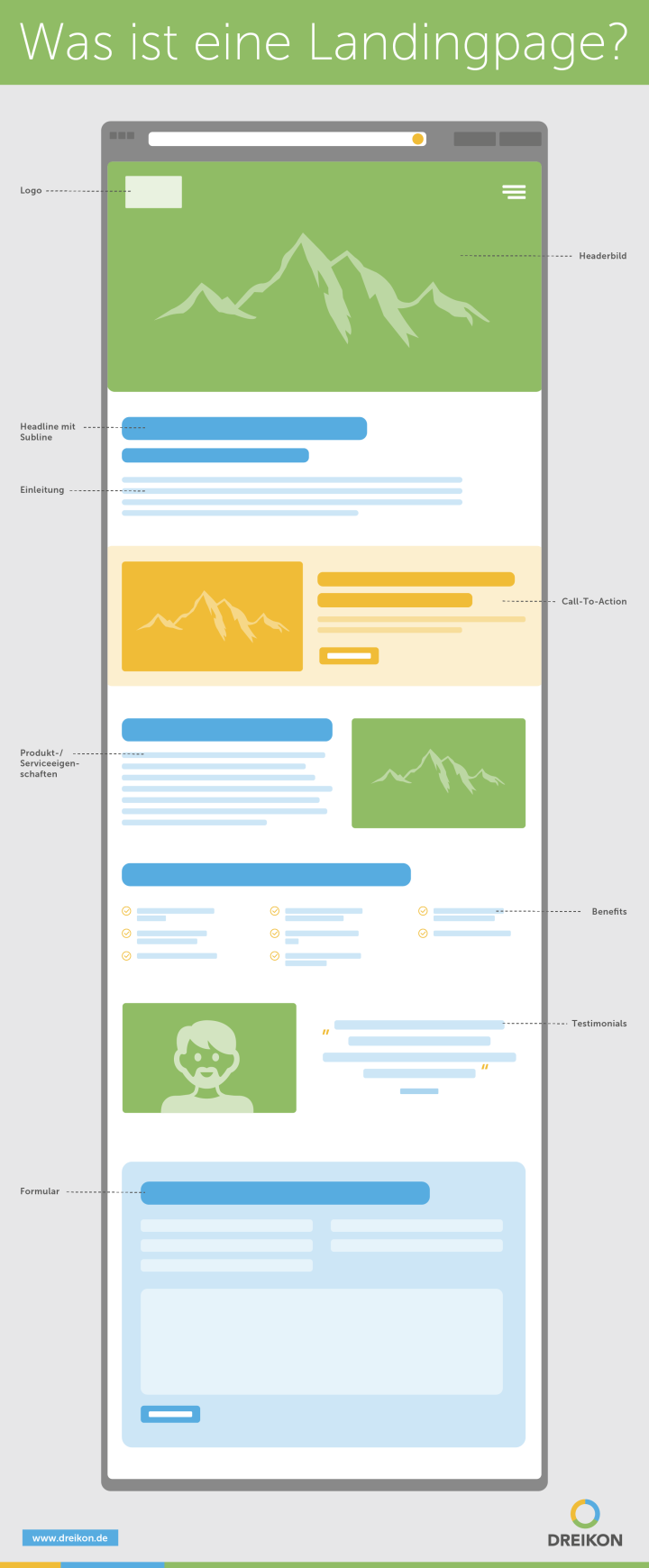Landing page
Anyone who deals with the creation of websites or online marketing will sooner or later stumble across the term "landing page". But what exactly is a landing page? The term landing page comes from the English language and means "landing page" and is often also referred to as a target page. It is a dedicated, independent homepage or subpage of a website that visitors land on after clicking on a link in an email or on advertisements from Google, Bing, YouTube, Facebook, Instagram & Co. or after accessing an entry in the search engine results of Google, Bing or similar. Landing pages can also be used as a supplement in the print sector. URLs or practical QR codes can be placed on posters, flyers and advertisements to provide interested parties with further information in digital form.
What is a landing page compared to a website?
There are major differences between a website and a landing page. While websites usually pursue various goals and encourage users to click around and explore, landing pages are focused on a specific topic and pursue their own goal. This focus makes landing pages the best option for increasing the conversion rates of your marketing campaigns and reducing the cost of acquiring leads or sales. Users can access the information they are looking for directly and without detours. Landing pages can therefore be created as subpages of a website. Depending on the objective pursued, they can either be included in the page navigation or hidden.
Presence, lead generation & sales increase: the goals of a landing page
Landing pages are target pages that users come to after clicking on an advertisement or a search result that they have been shown via or as a result of a search query in the search engine. As a rule, visitors call these up deliberately because they expect an answer to their question, an offer to satisfy a need or similar. A good landing page therefore pursues a single goal and provides the user with information that encourages a specific action.
As a company or website operator, your aim is always to attract potential customers to your website, make your offer appealing and ultimately achieve conversions or purchases. Landing pages can be used in online marketing in all areas of the customer journey and thus pick up any customers at the point where they are - whether before, during or after the purchase. Accordingly, landing pages can be used for different purposes as part of a marketing strategy. If you want to reach as many users as possible, the entire marketing funnel should be covered with corresponding landing pages.
Gain reach & increase website traffic
Do you want to reach as many people in your target group as possible with your website? By distributing good content, you can make potential buyers aware of your company and your services. Regardless of whether visitors come to your landing page through organic or paid marketing measures, more traffic is automatically generated on your website. However, please note that increased traffic does not necessarily mean a higher conversion rate.
Lead generation
To pick up users who are still at the very beginning of the customer journey, you first want to capture their attention in order to draw them deeper into the sales funnel and transform them into a real prospect. While landing pages in an advertising context are often an integral part of lead advertising campaigns, landing pages can also be used independently to generate leads organically. With content optimized for the search engine, for example created by an SEO agency, your page will be displayed for relevant search queries.
Lead generation pages are usually designed to collect data and therefore almost always contain a form. B2B marketers and companies selling high-priced products use this type of landing page to build a list of potential customers. Providing free information in the form of e-books or webinars in exchange for contact information can be beneficial here. E-commerce brands can also use these pages for building customer lists and planned email marketing. Depending on the company, a lead can also mean a direct conversion.Increasing conversionsLanding pages are primarily suitable for all websites that are not only operated for pure knowledge transfer, but are also designed to generate conversions, such as sales pages. You can use them to achieve various conversions. A closer look also allows you to monitor the success of your marketing campaigns. The content of a landing page is entirely geared towards conversion - in other words, it should take customers or interested parties to the next phase of the sales funnel:
- Newsletter registration
- Download e-books, infographics & Co.
- Contacting & inquiries
- Sale of a service or product
What is a landing page - How users land on a landing page
You now know what a landing page is and what goals it can pursue. But how do customers get to this page? The pages are accessed by users who have actively decided to make a click. They can be picked up at various touch points along the customer journey. Users can reach your landing page via the following channels:
- Newsletter
- Social media
- Advertisements and display advertising
- Offline marketing
- Organic traffic
How users land on a landing page
- Newsletter: Email marketing is used to provide potential customers with attractive information and offers. These are teased in the newsletter and recipients receive a link to the corresponding landing page with further information and calls to action. Social media: Whether in the story, in posts or via social media ads - you can successfully redirect traffic to the desired landing pages via appropriate links.Advertisements and display advertising: Paid ads such as Google Ads or Bing Ads offer the opportunity to place paid but target group-oriented advertisements. If interested parties click on the ads, they receive more specific information on the linked landing page.Offline marketing: Although landing pages are primarily used in a digital context, they can complement offline marketing measures. Customers can easily access further landing pages on their smartphone or in their browser via inserted URLs, ideally shortened with a URL shortener, or QR codes on flyers, posters, banner ads and in advertisements.
- Organic traffic: The term "organic traffic" refers to all visitors that come from an unpaid source, e.g. from Google or Bing search results (SERPs). By creating relevant and unique content, you can ensure that your business appears more frequently in related search results. The higher your content ranks, the better. With search engine optimization, companies can influence the ranking of their landing pages.
What is a landing page - tools for creating them
Just as important as the structure and content is the appealing design of the landing page. A wide range of tools are available for creating landing pages. While you can use special landing page software to quickly and easily create your landing page as individually as possible, entire website builders also offer the option of creating landing pages. If you already have a content management system for your website, you can add the landing pages to the existing page tree and hide them in the navigation or structure if required. Are you still looking for a good content management system? We would be happy to advise you in detail and take care of the launch or relaunch of your website.
Elements & structure of a good landing page
A good landing page must be convincing and first and foremost one thing: clear. An appealing and well-structured layout without distracting from the essentials is therefore of great importance. The following elements should therefore be included on a landing page:
Recognition of the company
To ensure that the content of the landing page is associated with your company, a landing page must contain your company logo as a minimum requirement.
Headline and sub-headline
A crisp and meaningful headline tells the visitor at first glance what content they can expect from the page. As the potential customer can see from the headline alone whether they will find what they are looking for on the page, the headline should be formulated with care.
Main body
The body text of a landing page should be well structured and follow the typical structure of a text (introduction, main body, conclusion), whereby the conclusion is usually replaced by a call-to-action. The topic covered should be introduced with an inviting text passage before moving on to a meaningful main section in the next step. Information on the topic covered, product information, a list of benefits and unique selling points are the focus and are presented in the main section. Use subheadings to break up longer texts in particular and ensure that the reader does not lose the overview.
Trust
You can also support your offer by listing customer opinions and ratings. A landing page must inspire trust in order to ultimately convert interested parties into buyers.
Call-to-action (CTAs)
With your landing page, you want to encourage visitors to get in touch, buy a product or register for an event. Therefore, remind them regularly on the landing page with appropriate prompts. Based on the length of the content, you should ideally place several call-to-actions on the landing page.
Note: Avoid confusion! CTAs must not be contradictory or call for different actions!
Forms
Is your goal to use the page to obtain customer data or accept registrations? Then a corresponding form should not be missing. Keep the effort required to enter personal data as low as possible. The less information a user has to disclose, the more willing they will be to complete a registration form.
Infographic: What is a landing page? The right structure

Content & technical aspects
The content presented on the page is just as important as the structure of the page. The length of text and type of information can vary depending on the topic. When designing the page, however, you should make sure that your visitors can grasp all the important information at a glance. Therefore, place the most important facts "above the fold" - i.e. so high up that the user does not have to scroll for this information.
A landing page must not only be informative and clear, it must also function technically flawlessly. If it takes too long to load, interested users will leave and a potential buyer will be lost. Mobile presentation should not be neglected either. More and more users are surfing on their cell phones. To make a good impression on mobile, your landing page should also be optimized for smartphone users.
What is landing page optimization?
Search engine optimization (SEO) is of great importance if you want your landing page to rank in Google search engine results and consequently be found by customers. Rankings are very dynamic and require regular review and adaptation or updating of content. After an in-depth analysis of your landing page and your competitors' pages, you will have identified potential improvements for your own page. In addition to supporting backlinks, on-page optimizations are often carried out. The focus here is on adapting the content, including the use of relevant terms and keywords as well as content that corresponds to the search intent.
What is a landing page - conclusion
Landing pages are used in online marketing to generate traffic, leads and conversions. They pursue a specific goal and should not be confused with entire websites. In addition to qualitative and relevant content, the structure of the page must always be taken into account. The page must be attractively designed and have sufficient call-to-actions that allow visitors to contact you quickly and easily. For the search engine, and consequently also for visitors, the performance of landing pages should be checked regularly in order to be able to react to falling rankings with landing page optimization.








